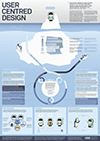What’s this all about?
The central premise of user centred design is that the best designed products and services result from understanding the needs of the people who will use them. —Design Council
As a Graphic Design student in my second year, I took a year of self-directed study during which I had the pleasure to work with many interesting design studios and practitioners which got me interested in user centred design.
Although I know that this diagram is by no means complete, I believe that it can be beneficial for students and design practitioners in various disciplines. I release it under a CC BY-NC-SA license with the hope that others will find it a useful tool for learning or teaching and to share and build upon.
Any questions?
Love it, hate it? I’m happy about any feedback. Get in touch and let me know what you think. Also drop me a line if you want to use or improve it. Thanks!
Get your copy
Feel free to download and share the digital version of the poster and make a donation if you found it useful.
What do you think it’s worth?
Thanks a lot to everyone who donated and ordered a printed copy of the poster. Those have all gone now. If you wish you can still donate to encourage and help me on my way to becoming a better designer.
Leave me a tip
£ 1A quid or a fiver. Whatever you can afford, it’s for a good cause!
Thank you!
Credits
This is an information graphic poster illustrating the underlying lifecycle, methods, principles and techniques in a user centred design process where the visual part is only the tip of the iceberg.
This project is the result of my work experience at City ID, an information design studio with international reputation. The poster sums up many of the things that I’ve learnt during my time working with them. It also draws inspiration from practitioners who I admire and from a Digital Media module that I took at the Zurich University of the Arts in Switzerland which was taught by visiting lecturer and user experience designer Eva-Lotta Lamm.
Credits and special thanks go to these great folks:
- The fantastic people at City ID
- Eva-Lotta at Skype London for her inspiring workshops and her colleague Steve ‘Buzz’ Pearce for providing the iceberg idea
- Jesse James Garrett and his great book “The Elements of User Experience”
- William Lidwell, Kritina Holden, Jill Butler and their master piece “Universal Principles of Design”
- The Design Council which has some good examples on their website.
- Peter Morville (www.semanticstudios.com) and Magnus Revang (userexperienceproject) whose diagrams provided a great starting point
- Leisa Reichelt (www.disambiguity.com) whose blog has been inspirational
- Flow Interactive who made a similar yet very simple UCD process diagram which has been a great source of inspiration
- Jason Clark who I had the brief pleasure of working with at City ID. He’s very knowledgable.










